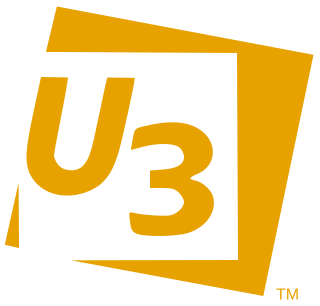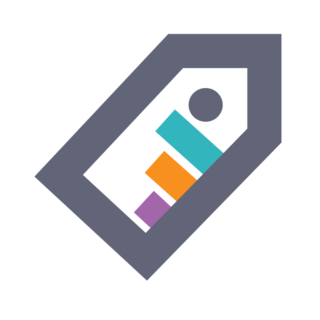Active Directory (AD) is a directory service developed by Microsoft for Windows domain networks. It is included in most Windows Server operating systems as a set of processes and services. Initially, Active Directory was used only for centralized domain management. However, Active Directory eventually became an umbrella title for a broad range of directory-based identity-related services.

An operating system (OS) is system software that manages computer hardware, software resources, and provides common services for computer programs.

Wiki software, is collaborative software that runs a wiki, which allows the users to create and collaboratively edit pages or entries via a web browser. A wiki system is usually a web application that runs on one or more web servers. The content, including previous revisions, is usually stored in either a file system or a database. Wikis are a type of web content management system, and the most commonly supported off-the-shelf software that web hosting facilities offer.
The resource fork is a fork or section of a file on Apple's classic Mac OS operating system, which was also carried over to the modern macOS for compatibility, used to store structured data along with the unstructured data stored within the data fork.
Project management software (PMS) has the capacity to help plan, organize, and manage resource tools and develop resource estimates. Depending on the sophistication of the software, it can manage estimation and planning, scheduling, cost control and budget management, resource allocation, collaboration software, communication, decision-making, quality management, time management and documentation or administration systems. Numerous PC and browser-based project management software and contract management software products and services are available.
An application program is a computer program designed to carry out a specific task other than one relating to the operation of the computer itself, typically to be used by end-users. Word processors, media players, and accounting software are examples. The collective noun "application software" refers to all applications collectively. The other principal classifications of software are system software, relating to the operation of the computer, and utility software ("utilities").

Mobile computing is human–computer interaction in which a computer is expected to be transported during normal usage, which allows for the transmission of data, voice, and video. Mobile computing involves mobile communication, mobile hardware, and mobile software. Communication issues include ad hoc networks and infrastructure networks as well as communication properties, protocols, data formats, and concrete technologies. Hardware includes mobile devices or device components. Mobile software deals with the characteristics and requirements of mobile applications.
In computer science and networking in particular, a session is a time-delimited two-way link, a practical layer in the tcp/ip protocol enabling interactive expression and information exchange between two or more communication devices or ends – be they computers, automated systems, or live active users. A session is established at a certain point in time, and then ‘torn down’ - brought to an end - at some later point. An established communication session may involve more than one message in each direction. A session is typically stateful, meaning that at least one of the communicating parties needs to hold current state information and save information about the session history to be able to communicate, as opposed to stateless communication, where the communication consists of independent requests with responses.

In computing, file system or filesystem is a method and data structure that the operating system uses to control how data is stored and retrieved. Without a file system, data placed in a storage medium would be one large body of data with no way to tell where one piece of data stopped and the next began, or where any piece of data was located when it was time to retrieve it. By separating the data into pieces and giving each piece a name, the data are easily isolated and identified. Taking its name from the way a paper-based data management system is named, each group of data is called a "file". The structure and logic rules used to manage the groups of data and their names is called a "file system."

The Windows Registry is a hierarchical database that stores low-level settings for the Microsoft Windows operating system and for applications that opt to use the registry. The kernel, device drivers, services, Security Accounts Manager, and user interfaces can all use the registry. The registry also allows access to counters for profiling system performance.
Enterprise content management (ECM) extends the concept of content management by adding a timeline for each content item and, possibly, enforcing processes for its creation, approval and distribution. Systems using ECM generally provide a secure repository for managed items, analog or digital. They also include one methods for importing content to bring manage new items, and several presentation methods to make items available for use. Although ECM content may be protected by digital rights management (DRM), it is not required. ECM is distinguished from general content management by its cognizance of the processes and procedures of the enterprise for which it is created.

U3 was a joint venture between SanDisk and M-Systems, producing a proprietary method of launching Windows software from special USB flash drives. Flash drives adhering to the U3 specification are termed "U3 smart drives". U3 smart drives come preinstalled with the U3 Launchpad. Applications that comply with U3 specifications are allowed to write files or registry information to the host computer, but they must remove this information when the flash drive is ejected. Customizations and settings are instead stored with the application on the flash drive.

A portable application, sometimes also called standalone, is a program designed to read and write its configuration settings into an accessible folder in the computer, usually in the folder where the portable application can be found. This makes it easier to transfer the program with the user's preferences and data between different computers. A program that doesn't have any configuration options can also be a portable application.
A password manager is a computer program that allows users to store, generate, and manage their passwords for local applications and online services.
Data portability is a concept to protect users from having their data stored in "silos" or "walled gardens" that are incompatible with one another, i.e. closed platforms, thus subjecting them to vendor lock-in and making the creation of data backups or moving accounts between services difficult.
Remote Desktop Services (RDS), known as Terminal Services in Windows Server 2008 and earlier, is one of the components of Microsoft Windows that allow a user to initiate and control an interactive session on a remote computer or virtual machine over a network connection. RDS was first released in 1998 as Terminal Server in Windows NT 4.0 Terminal Server Edition, a stand-alone edition of Windows NT 4.0 Server that allowed users to log in remotely. Starting with Windows 2000, it was integrated under the name of Terminal Services as an optional component in the server editions of the Windows NT family of operating systems, receiving updates and improvements with each version of Windows. Terminal Services were then renamed to Remote Desktop Services with Windows Server 2008 R2 in 2009.

GroupWise is a messaging and collaboration platform from Micro Focus that supports email, calendaring, personal information management, instant messaging, and document management. The GroupWise platform consists of desktop client software, which is available for Windows,, and the server software, which is supported on Windows Server and Linux.
A mobile application or app is a computer program or software application designed to run on a mobile device such as a phone, tablet, or watch. Mobile applications often stand in contrast to desktop applications which are designed to run on desktop computers, and web applications which run in mobile web browsers rather than directly on the mobile device.

TagSpaces is an open-source data manager and file navigator. It helps organize files on local drives by adding tags to files. Users get the same user interface to manage their files on different platforms. TagSpaces is compatible with Windows, Linux, Mac, Android, iPhone, Firefox and Chrome. The application requires neither internet connection, nor user's registration to run both on desktop and portable devices.





